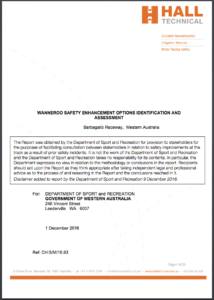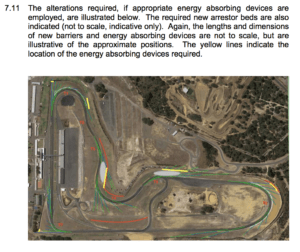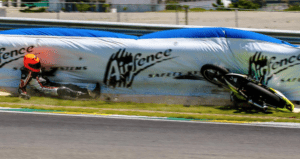
Cheap option deletes the ess-bend
BARBAGALLO Raceway’s famed ess-bend could be deleted from the circuit if authorities opt for a cheapest-possible solution to safety concerns raised in a report to the West Australian State Government.
The report, which has led to bikes being banished from the Wanneroo circuit since November 10, was released in its entirety yesterday by the Department of Sport and Recreation — including details of what it’s likely to cost to address safety issues. 
Report author Chris Hall says in the document that the most simple and cost-effective solution to problems he has raised would be realignment of sections of the track “but that would involve reducing the length of an already short circuit and would remove the more interesting driving/riding elements”.
The ess-bend at turns 2 and 3 would be deleted under that option. Mr Hall said a second option — upgrading and slightly lengthening the circuit — was likely to cost in the order of $1.7 – $2.5 million, while an all-new circuit in a new location would likely cost up to $6.5m plus land.
The report highlights multiple safety issues at Barbagallo, the most serious being inadequate run-off areas and others including poor transition from the racing surface into run-off areas, the width of the track, and the type of kerbing.
“In its current layout and barrier design, the circuit is associated with a significant number of critical risk items that render it unsafe for motorcycle racing,” the report says.

“Many of the safety issues associated with the insufficient run-offs can be overcome for the short to medium term, without altering barrier alignments, through designed placement, alignment and construction of appropriate energy absorbing devices.
“However, turn 3 requires re-alignment of the barrier or of the circuit to reduce the risk of rider injury to an acceptable level.”

Mr Hall says the circuit has “extreme” risk levels for bikes at turn 3 (the second half of the ess-bend), turn 6 (in ‘the bowl’) and turn 7 (entry onto the main straight). Perth rider Daniel Chadbund was killed when he crashed at turn 7 in May.
The report covers safety concerns for bikes and also for car racing.
“It is obvious from a risk assessment that the highlighted safety issues are much more critical from the perspective of motorcycle competitors than they are for the car drivers,” it says.
“That is not surprising given the speeds involved, the reduced deceleration applying to a fallen rider compared with that which a driver can achieve in his/her car, and the exposure to injury when an impact with a barrier does occur.”
Mr Hall made particular mention of the different scenarios in which run-offs were used by the different racing disciplines, and also of a rider who has come off his bike compared with a rider still in control.
“Historically, the main aim of run-off lengths was to enable drivers and riders who leave the track sufficient room to brake and avoid colliding with a barrier put in place to protect spectators or other competitors (in the event that the off track excursion could result in another section of the track being crossed),” he said.
“It is now known that a fallen rider sliding over a bitumen surface and/or a grassed/compacted earth surface will decelerate at a lower level than an upright rider can achieve on his motorcycle.

“Since a common feature of motorcycle racing incidents involves a rider falling to the track (low side on entry to and up to the apex of a bend; high side in exit sector), it is appropriate to consider run-off lengths in relation to fallen riders.” 
Other stories you might like:
Honda’s ‘V8’ race bike from the past

